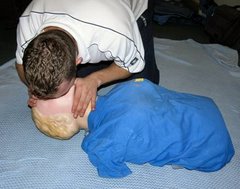Head Injuries 3: SKULL FRACTURE
If the mode of injury is a heavy blow to the head suspect a skull fracture. A skull fracture is a very serious injury due to the possibility of underlying damage to the brain. It is good practice to suspect a skull fracture for any casualty that has an obvious head wound or impaired consciousness - treat for the worst, hopefully it won't be that bad. Always suspect that a casualty with a severe head injury has a spinal injury too - maintain a neutral alignment of the casualty's neck and back.
Recognition:
- Wound or bruise to the head.
- Soft area or depression of the scalp.
- Bruising or swelling behind one ear.
- Bruising around one or both eyes.
- Loss of a clear, watery fluid (cerebrospinal fluid) from the ear (a very obvious tell tale sign).
- Blood shot eyes.
- Distortion or loss of symmetry about the head or face.
- Deteriorating responsiveness. Casualty may become unconscious.
Aims:
- To get urgent medical help.
- To maintain the casualty's airway and breathing.
Treatment:
- If the casualty is conscious help them to lie down. Support the casualty's head. Do not allow the head to rock or turn.
- Control any bleeding from the head by direct pressure.
- Send for urgent help. If you are by yourself go and summon help and return to the casualty quickly.
- If there is a discharge from the ear, lightly cover it with a sterile dressing or pad. Do not plug the ear.
- Monitor the casualty's responsiveness, airway, breathing and pulse. If the casualty stops breathing be prepared to perform resuscitation.






